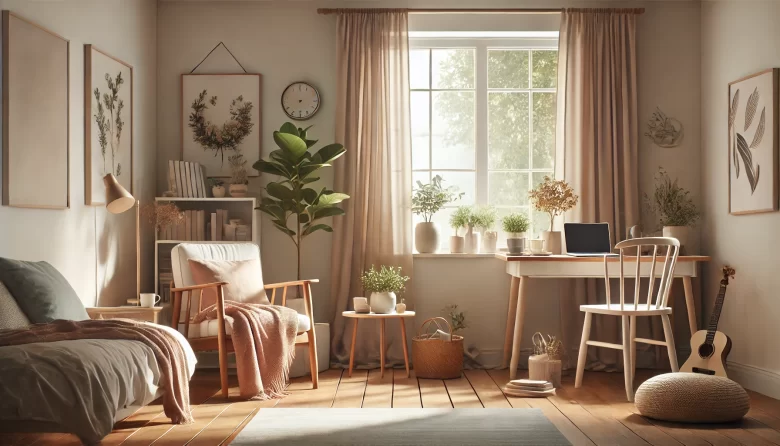In today’s fast-paced world, it often feels like stress is an unavoidable part of life. Between work deadlines, social media notifications, and the constant pressure to do more, it’s no wonder that many of us are feeling overwhelmed. But what if there was a simpler way to approach life, one that not only reduces stress but also enhances your well-being?
Enter the concept of Simplified Well-Being—a lifestyle that focuses on cutting through the noise and focusing on what truly matters. It’s about reducing the chaos in our lives, both internally and externally, in order to create a healthier and more peaceful environment. By simplifying your daily habits, routines, and surroundings, you can significantly lower your stress levels and improve your physical and mental well-being.
Understanding Simplified Well-Being
Definition of Simplified Well-Being
Simplified well-being is all about embracing a lifestyle that reduces complexity and fosters balance. It’s not about doing less for the sake of laziness, but rather focusing on what truly contributes to your mental and physical health. In today’s world, we’re constantly bombarded with distractions—rushed schedules, excessive consumerism, and endless digital stimulation—which can take a toll on our well-being. Simplified well-being encourages us to simplify our routines, declutter our environments, and prioritize activities that nourish our minds, bodies, and souls. It’s a holistic approach that integrates physical health with mental peace, allowing us to thrive in both aspects of life.
The Connection Between Stress and Environment
One of the key factors that contribute to stress is the environment we surround ourselves with. Our physical space, whether it’s our home, workplace, or even the city we live in, plays a significant role in how we feel and think. An overcrowded, disorganized, or noisy environment can lead to increased anxiety and a sense of overwhelm. Likewise, the digital space we inhabit—constant emails, social media notifications, and work-related alerts—can add another layer of stress.
Our surroundings have a direct impact on our emotional and mental states. If we are constantly exposed to chaos or clutter, it becomes much harder to achieve mental clarity and peace. On the other hand, creating a calm, organized, and soothing environment can have a profound effect on reducing stress and improving overall well-being.
The Importance of Both
Achieving simplified well-being means understanding that both internal and external factors need to be in harmony. While we can take steps to organize our environment and reduce stressors externally, it’s equally important to focus on our mental health. Mental well-being—through practices like mindfulness, emotional regulation, and self-compassion—supports the internal balance needed to fully benefit from a simplified environment.
When we balance both our inner peace and our external surroundings, we create a foundation for sustainable well-being. It’s not about removing all sources of stress or eliminating everything that feels overwhelming, but about making conscious decisions to prioritize what supports our health. Simplifying both your mental space and your physical space will ultimately lead to a more fulfilling and stress-free life.
Identifying the Sources of Stress
External Stressors
Our modern world is filled with stressors that come from external sources, many of which we often have little control over. Work-related pressures are a common culprit, with deadlines, meetings, and the constant demand to perform often leading to burnout. Social media adds another layer of stress, as the constant comparisons and the overwhelming flow of information can make us feel inadequate or anxious.
Environmental factors like pollution, overcrowded cities, and noise also contribute to stress, particularly when we are exposed to them for long periods. The noise from traffic, construction, or bustling city life can disrupt our peace and add to a general sense of unease. While we might not be able to eliminate these external stressors entirely, becoming aware of them is the first step toward managing their impact on our well-being.
Internal Stressors
While external factors are significant, we also need to acknowledge the internal stressors that stem from our own thoughts and attitudes. Negative thinking patterns—such as self-criticism, pessimism, or excessive worry—can create a constant state of tension within the mind and body. Unrealistic expectations, whether they are set by others or ourselves, can lead to feelings of failure when they’re not met, further adding to stress.
Another internal stressor is the lack of self-care. In our busy lives, we often neglect our physical and emotional needs, whether it’s skipping meals, not getting enough sleep, or failing to make time for relaxation. These patterns can slowly accumulate, leaving us feeling exhausted and mentally drained.
How Stress Affects the Body
Prolonged exposure to stress—both external and internal—can have serious consequences for both our physical and mental health. When we’re stressed, our bodies release hormones like cortisol and adrenaline, which are designed to help us respond to immediate threats. However, when stress is constant, these hormones remain elevated, leading to a range of health issues.
Physically, chronic stress can contribute to fatigue, digestive issues, headaches, and sleep disturbances. The immune system also becomes compromised, making us more susceptible to illness. Over time, this can lead to chronic conditions like high blood pressure, heart disease, or autoimmune disorders.
Simplifying Your Environment to Reduce Stress
Decluttering Your Space
One of the easiest and most effective ways to reduce stress is by decluttering your environment. A disorganized or cluttered space can create a sense of chaos, leading to feelings of overwhelm and distraction. The first step in creating a calm, peaceful environment is to take a look at your surroundings and start eliminating the items that no longer serve a purpose. This could mean cleaning out your desk, sorting through closets, or organizing your living areas.
To make the process manageable, begin by tackling one area at a time. Set aside a few minutes each day to sort through papers, throw away unused items, or donate things you no longer need. A tidy space promotes clarity and order, which can help ease anxiety and create a sense of calm. You’ll find that as you declutter, you not only free up physical space but also create mental space for more peace and relaxation.
Natural Elements
Incorporating natural elements into your environment is another powerful way to reduce stress and enhance your well-being. Nature has a calming effect on the mind, and bringing aspects of the outdoors inside can have an immediate impact on your mood. Plants, for example, are known to improve air quality and reduce stress levels. Simply placing a few indoor plants in your home or office can help purify the air and provide a soothing green presence that promotes relaxation.
Natural light is equally important. Exposure to natural sunlight helps regulate your circadian rhythm, improves sleep, and boosts mood by increasing serotonin levels. If possible, position your workspace or living area near a window to take advantage of daylight. Additionally, ensuring that your space is well-ventilated with fresh air can help reduce stress and create a more comfortable atmosphere. Opening windows or using air purifiers can make your environment feel fresher and more inviting.
Minimizing Noise Pollution
Noise is one of the most pervasive stressors in modern life. Whether it’s the hum of traffic, loud conversations, or constant background noise from electronics, noise pollution can have a significant impact on our mental health. To reduce stress, it’s important to create a quieter, more peaceful environment.
Start by assessing the noise levels in your space. If you live in a noisy area, consider using noise-canceling headphones or soundproofing techniques, such as installing heavy curtains or acoustic panels. Adding soft furnishings like rugs, cushions, and upholstered furniture can help absorb sound and reduce echo. If possible, you might also want to create designated quiet zones within your home, where you can retreat to unwind and recharge.
Mindful Design
The way you arrange your furniture and design your space can play a significant role in how you feel within it. Mindful design is all about choosing furniture, decor, and layouts that promote relaxation and well-being. Start by considering the flow of your space. Cluttered and cramped spaces can feel stressful, while open, airy layouts encourage ease and comfort. Choose simple, functional furniture that fits the space without overwhelming it, and leave enough room for movement and relaxation.
The colors you choose for your space can also impact your mood. Calming hues like soft blues, greens, and neutrals tend to create a more serene atmosphere, while bold or intense colors may have the opposite effect. Pay attention to lighting as well—soft, warm lighting is more relaxing than harsh, bright lights. Incorporating personal touches like meaningful artwork or items that make you feel at peace can also enhance the sense of calm in your space.
Simplified Well-Being Practices for Stress Reduction
Mindfulness and Meditation
In the hustle and bustle of daily life, it’s easy to get caught up in thoughts about the past or future, which only adds to stress and anxiety. One of the most effective ways to combat this is through mindfulness and meditation. These practices help you reconnect with the present moment, quieting the mind and allowing you to fully experience the here and now.
Mindfulness can be practiced at any moment throughout your day. It’s as simple as focusing your attention on your breath, sensations, or surroundings without judgment. Whether you’re drinking a cup of tea or walking to work, taking a few seconds to tune into your senses can be incredibly calming. Meditation, on the other hand, allows you to set aside dedicated time to focus inward. Even just a few minutes of meditation each day can help reduce stress, increase clarity, and improve overall emotional health. Apps like Headspace or Calm offer guided meditations, making it easy for beginners to start.
Breathing Techniques
One of the quickest ways to reduce stress and calm your body is through deep breathing. When we’re stressed, our breathing becomes shallow, which can exacerbate feelings of anxiety. By practicing intentional breathing, you can activate your body’s relaxation response, lowering your heart rate and easing tension.
Try the simple technique of deep belly breathing: Inhale slowly through your nose for a count of four, allowing your belly to expand, then exhale through your mouth for a count of six. This technique helps activate the parasympathetic nervous system, which is responsible for calming the body. You can practice this anywhere—whether you’re sitting at your desk, waiting in line, or lying in bed. Breathing exercises like this can help you instantly reduce stress and regain a sense of calm.
Physical Movement
Physical movement is another powerful way to reduce stress and improve overall well-being. When we move our bodies, we release endorphins—natural chemicals that promote a sense of happiness and well-being. Regular movement, whether through stretching, yoga, or walking, not only improves our physical health but also helps to clear mental fog and relieve tension.
Yoga is particularly effective for reducing stress because it combines physical movement with deep breathing and mindfulness. Poses like Child’s Pose, Downward Dog, or the Cat-Cow stretch can release tension in the body and help you relax. If yoga isn’t your thing, simply taking a brisk walk outside can work wonders to clear your mind and reduce stress. The key is to find an activity that feels good to you and make it a regular part of your routine.
Digital Detox
In today’s digital age, we’re constantly plugged into screens—whether it’s our phones, computers, or televisions. While technology has its benefits, excessive screen time, especially on social media, can increase feelings of stress and anxiety. Constant exposure to news, comparisons, and notifications can overwhelm our minds and take away from our ability to truly relax.
A digital detox is a great way to reduce stress and improve well-being. Start by setting boundaries around your screen time. Designate certain hours of the day for checking emails or social media, and avoid screens during meals or before bed. Consider spending one day a week—such as a weekend day—without any digital devices, allowing yourself to truly unplug and recharge. This break from technology can help foster a greater sense of peace, allowing you to reconnect with yourself and the world around you.
Incorporating these simple practices into your daily routine can significantly reduce stress and promote a sense of well-being. Whether through mindfulness, breathing exercises, physical movement, or a digital detox, these strategies empower you to take control of your mental and physical health, creating a more peaceful and balanced life.
Creating a Harmonious Environment for Long-Term Well-Being
Sustainable Living
Living sustainably isn’t just about protecting the environment—it’s also about creating a healthier, more balanced lifestyle for yourself. Making eco-friendly choices in your daily life can have a profound impact on your overall well-being. When you choose to live in harmony with the earth, you are not only reducing your carbon footprint but also fostering a sense of responsibility and connection to the world around you.
Start with simple, everyday changes: choose reusable products over disposable ones, support local and organic food producers, and reduce your use of plastic. These small acts can reduce stress by promoting a cleaner, healthier environment. You can also consider making your home more energy-efficient by switching to LED lights, using natural cleaning products, or reducing water consumption. The act of contributing to a healthier planet can bring a sense of fulfillment and peace, knowing you’re making a positive impact.
Personal Boundaries
One of the most essential components of long-term well-being is the ability to set and maintain personal boundaries. In a world where we’re often expected to do more and be available at all times, setting limits on work, social obligations, and even screen time is crucial for reducing stress and preserving mental health.
Start by identifying the areas in your life where you feel overwhelmed or stretched too thin. Whether it’s saying no to extra tasks at work or cutting back on social commitments, setting clear boundaries ensures you’re not overcommitting yourself. You also have the power to set boundaries with technology. Limit your screen time, mute non-urgent notifications, and take breaks from digital devices to allow your mind to rest. By learning to say no when necessary, you protect your time and energy, which ultimately leads to less stress and more well-being.
Building Meaningful Relationships
Humans are inherently social creatures, and having strong, supportive relationships is vital for mental and emotional well-being. Building and nurturing meaningful connections with friends, family, and loved ones provides a solid foundation of support that can help you navigate life’s challenges with greater ease. Whether it’s sharing a laugh with a friend, receiving advice from a family member, or simply spending quality time with someone you care about, these social interactions provide emotional nourishment.
In addition to maintaining existing relationships, make time to cultivate new ones. Engage in activities that align with your interests, such as joining a hobby group or volunteering for a cause you care about. Meaningful relationships foster a sense of belonging and provide emotional resilience, which is crucial for handling stress and maintaining long-term well-being.
The Role of Diet and Sleep in Well-Being
Nourishing the Body
What we eat plays a critical role in both our physical and mental well-being. Our bodies rely on nutrients from food to fuel our daily activities, maintain energy levels, and support cognitive function. Eating a balanced diet of simple, wholesome foods can significantly reduce stress, boost mood, and improve overall health.
Focus on incorporating whole, nutrient-dense foods into your meals—fresh fruits and vegetables, lean proteins, whole grains, and healthy fats. These foods provide essential vitamins and minerals that support brain function, regulate mood, and stabilize energy levels throughout the day. Avoiding processed foods, refined sugars, and excessive caffeine can help prevent energy crashes and irritability, which are common when our blood sugar levels fluctuate.
Sleep Hygiene
Quality sleep is crucial for maintaining both physical health and emotional well-being. When we’re well-rested, our bodies can repair and rejuvenate, and our minds are better equipped to handle stress. Unfortunately, many people struggle with sleep, whether it’s difficulty falling asleep, staying asleep, or waking up feeling fatigued. However, improving sleep hygiene can help you get the rest you need and reduce the negative impact of stress.
Start by establishing a consistent sleep schedule. Going to bed and waking up at the same time each day helps regulate your body’s internal clock, making it easier to fall asleep and wake up feeling refreshed. Create a relaxing bedtime routine, such as reading, meditating, or taking a warm bath, to signal to your body that it’s time to unwind.
In today’s fast-paced world, simplifying both our internal and external environments can have a profound impact on our overall well-being. By reducing stressors in our physical space—such as decluttering, incorporating natural elements, and creating a peaceful atmosphere—we can foster a calm, supportive environment for both our body and mind. Similarly, adopting practices like mindfulness, breathing techniques, and physical movement can help us manage internal stress, improving our mental clarity and emotional resilience.




